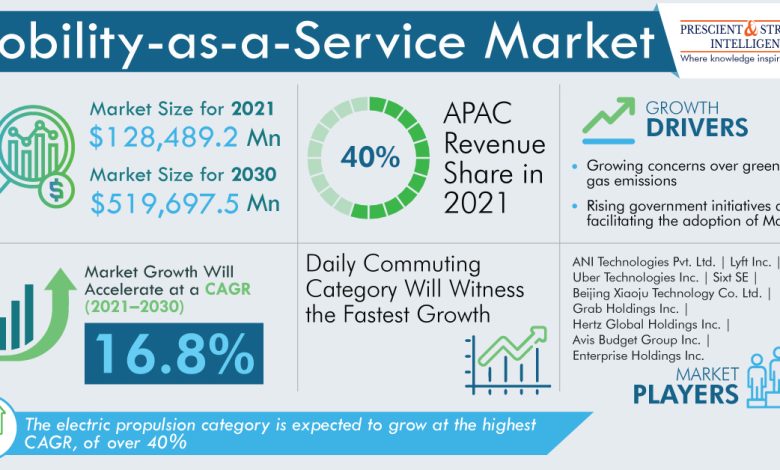Disrupting Transportation: Insights into the Mobility-as-a-Service Market
Mobility-as-a-Service Market Report

Understanding the Impact of MaaS on Urban Transportation Landscape
Mobility as a Service integrates several methods of transport and transport-associated services into a single, wide-ranging, and on-demand mobility facility. MaaS provides end-users, the additional value of accessing mobility via a single application and a single payment method in its place of multiple ticketing and payment processes.
To meet a customer’s demand a MaaS operator hosts a variety of transport choices, such as public transport, active modes like cycling and walking, riding, car, bike-sharing, taxi, and car lease or rental, or a grouping thereof. MaaS aims to be the best value scheme for the environment, and users.
Understanding the Shift towards a Subscription-based Transportation Model
A successful MaaS facility also provides new occupational models and ways to organize and function the several transport options, with benefits for transport workers, such as access to better user and demand data and new openings to cater to an unmet requirement.
MaaS targets to offer a substitute to utilizing the private vehicle that can be more convenient, and workable, support in reducing congestion and restraints in transport capacity, and be even more economical. The mobility-as-a-service market is experiencing growth and is projected to reach USD 519,697.5 million by 2030.
Why Do We Need Mobility As a Service?
MaaS satisfies the users’ requirement for mobility with an extensive range of transport services for both goods and travelers, providing ideal transport on demand. A MaaS service provider assembles the most appropriate transportation means to meet a customer’s requirements, car rental, taxi, whether public transport or even ride-, car- or bike-sharing.
The potential advantages of the successful execution of MaaS include:
- Simpler and improved user interaction with the transport network, with multimodal access.
- Accessibility of personalized solutions to meet customers’ requirements getting where they want at the accurate time and suitable cost and transport network demand efficacies and removal of low-demand services and related prices.
- Integrated systems ensure information sharing among customers and transport operators and owners.
- Enhanced efficacies in transporting goods and people, bottleneck and overcrowding are reduced, and decreased commutation time has the potential for time and well-being for travelers and economic advantages for businesses.
- Eco-friendly
Better vehicle utilization
MaaS services offer the prospect to decrease the overall number of vehicles throughout the community. If you think about cars as an asset, you have to invest a lot of time on the roads. Stuck in traffic jams the so-called asset is going to be utilized properly. Instead of sitting lazily in a garage or parking, other people could utilize your vehicle. Usage of a vehicle by more people means that overall, fewer cars are required to be on the road.
Conclusion
Progressively, ever more metropolises all over the globe are testing Mobility as a Service. Mobility service contributions however differ from city to city. But for the MaaS project to work, the slightest integration level must at least involve the integration of booking. Payment of mobility service in a given service area.
MaaS is still in its infancy globally, thus deployments like those illustrated above are accumulating valuable knowledge that will be used to improve subsequent deployments and comprehend the advantages and disadvantages of MaaS. For example, according to TMR, MaaS might benefit the transport network to the amount of AUD 40 billion to AUD 46 billion. This financial gain alone demonstrates the potential effects of MaaS on the transportation industry and the larger community.
Exploring the Impact of MaaS on Urban Transportation and Future Mobility Trends
In the past, the ride-hailing sector had a mobility-as-a-service market share of more than 50%. The demand for ride-hailing services is rising as a result of the global development of the travel and tourism sector as well as the conversion of traditional offline systems to online systems. Additionally, during the forecast period, the micro-mobility category is anticipated to increase at the fastest rate. In response to measures to manage the COVID-19 illness, such as shelter-at-home orders, local travel habits are changing rapidly.
What Are the Advantages of Mobility as a Service?
Easy route planning — Users using real-time route planning can make travel arrangements utilizing a variety of modes of transportation using intelligent suggestions based on their preferences.
Simplified payments — Users of MaaS have the option of paying for their transportation before or after their trip, in advance, or as part of a subscription, using their phones, smartwatches, and bank cards.
The personal touch — MaaS is a completely customized solution that fosters communication between customers and the transportation company. MaaS systems develop to become the ideal customer-focused transportation platform by utilizing big data, two-way communication, and continuous user input.
MaaS Market Growth Drivers
Daily commuting now has the largest mobility-as-a-service market share and is projected to expand at the fastest rate—more than 17%—in the coming years. The growth in this industry may be largely due to the youthful population’s rising desire for shared mobility services to suit their daily commuting demands, particularly among students and young professionals. The usage of shared mobility between individuals is also anticipated to be encouraged by a variety of efforts designed to decrease the count of private automobiles on the road.
Globally, the business is being driven by escalating environmental concerns, particularly as a result of a quicker pace of environmental deterioration and ozone layer depletion. Environmental authorities’ worries about the deterioration of air quality brought on by growing levels of vehicle exhaust emissions have paved the way for several international efforts, including emission control rules. As a result, it has emerged as one of the most effective methods for combating pollution’s damaging impacts on the environment. As a result, this aspect increases demand for MaaS.



